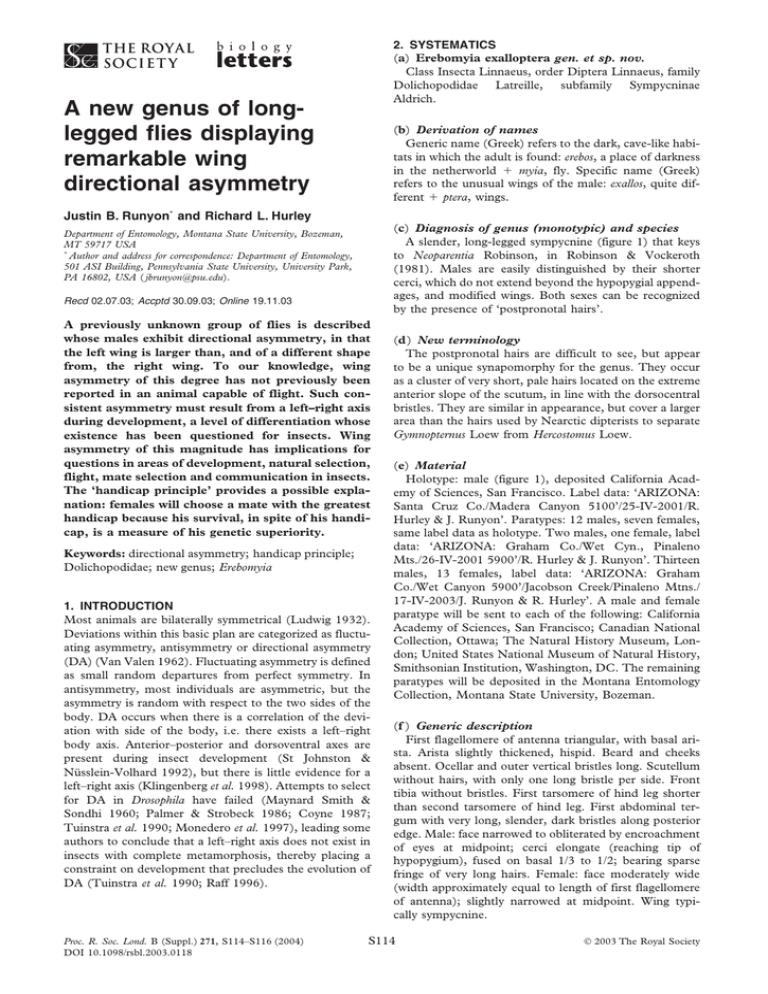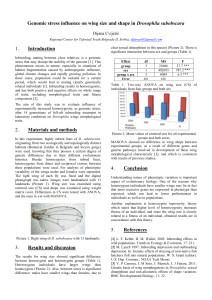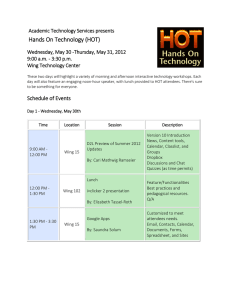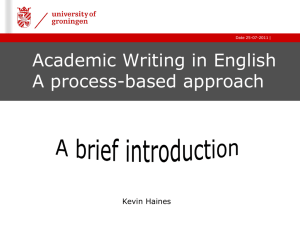2. SYSTEMATICS a Class Insecta Linnaeus, order Diptera Linnaeus, family Dolichopodidae
advertisement

2. SYSTEMATICS (a) Erebomyia exalloptera gen. et sp. nov. Class Insecta Linnaeus, order Diptera Linnaeus, family Dolichopodidae Latreille, subfamily Sympycninae Aldrich. A new genus of longlegged flies displaying remarkable wing directional asymmetry (b) Derivation of names Generic name (Greek) refers to the dark, cave-like habitats in which the adult is found: erebos, a place of darkness in the netherworld ⫹ myia, fly. Specific name (Greek) refers to the unusual wings of the male: exallos, quite different ⫹ ptera, wings. Justin B. Runyon* and Richard L. Hurley (c) Diagnosis of genus (monotypic) and species A slender, long-legged sympycnine (figure 1) that keys to Neoparentia Robinson, in Robinson & Vockeroth (1981). Males are easily distinguished by their shorter cerci, which do not extend beyond the hypopygial appendages, and modified wings. Both sexes can be recognized by the presence of ‘postpronotal hairs’. Department of Entomology, Montana State University, Bozeman, MT 59717 USA * Author and address for correspondence: Department of Entomology, 501 ASI Building, Pennsylvania State University, University Park, PA 16802, USA ( jbrunyon@psu.edu). Recd 02.07.03; Accptd 30.09.03; Online 19.11.03 A previously unknown group of flies is described whose males exhibit directional asymmetry, in that the left wing is larger than, and of a different shape from, the right wing. To our knowledge, wing asymmetry of this degree has not previously been reported in an animal capable of flight. Such consistent asymmetry must result from a left–right axis during development, a level of differentiation whose existence has been questioned for insects. Wing asymmetry of this magnitude has implications for questions in areas of development, natural selection, flight, mate selection and communication in insects. The ‘handicap principle’ provides a possible explanation: females will choose a mate with the greatest handicap because his survival, in spite of his handicap, is a measure of his genetic superiority. Keywords: directional asymmetry; handicap principle; Dolichopodidae; new genus; Erebomyia 1. INTRODUCTION Most animals are bilaterally symmetrical (Ludwig 1932). Deviations within this basic plan are categorized as fluctuating asymmetry, antisymmetry or directional asymmetry (DA) (Van Valen 1962). Fluctuating asymmetry is defined as small random departures from perfect symmetry. In antisymmetry, most individuals are asymmetric, but the asymmetry is random with respect to the two sides of the body. DA occurs when there is a correlation of the deviation with side of the body, i.e. there exists a left–right body axis. Anterior–posterior and dorsoventral axes are present during insect development (St Johnston & Nüsslein-Volhard 1992), but there is little evidence for a left–right axis (Klingenberg et al. 1998). Attempts to select for DA in Drosophila have failed (Maynard Smith & Sondhi 1960; Palmer & Strobeck 1986; Coyne 1987; Tuinstra et al. 1990; Monedero et al. 1997), leading some authors to conclude that a left–right axis does not exist in insects with complete metamorphosis, thereby placing a constraint on development that precludes the evolution of DA (Tuinstra et al. 1990; Raff 1996). Proc. R. Soc. Lond. B (Suppl.) 271, S114–S116 (2004) DOI 10.1098/rsbl.2003.0118 (d ) New terminology The postpronotal hairs are difficult to see, but appear to be a unique synapomorphy for the genus. They occur as a cluster of very short, pale hairs located on the extreme anterior slope of the scutum, in line with the dorsocentral bristles. They are similar in appearance, but cover a larger area than the hairs used by Nearctic dipterists to separate Gymnopternus Loew from Hercostomus Loew. (e) Material Holotype: male (figure 1), deposited California Academy of Sciences, San Francisco. Label data: ‘ARIZONA: Santa Cruz Co./Madera Canyon 5100’/25-IV-2001/R. Hurley & J. Runyon’. Paratypes: 12 males, seven females, same label data as holotype. Two males, one female, label data: ‘ARIZONA: Graham Co./Wet Cyn., Pinaleno Mts./26-IV-2001 5900’/R. Hurley & J. Runyon’. Thirteen males, 13 females, label data: ‘ARIZONA: Graham Co./Wet Canyon 5900’/Jacobson Creek/Pinaleno Mtns./ 17-IV-2003/J. Runyon & R. Hurley’. A male and female paratype will be sent to each of the following: California Academy of Sciences, San Francisco; Canadian National Collection, Ottawa; The Natural History Museum, London; United States National Museum of Natural History, Smithsonian Institution, Washington, DC. The remaining paratypes will be deposited in the Montana Entomology Collection, Montana State University, Bozeman. (f ) Generic description First flagellomere of antenna triangular, with basal arista. Arista slightly thickened, hispid. Beard and cheeks absent. Ocellar and outer vertical bristles long. Scutellum without hairs, with only one long bristle per side. Front tibia without bristles. First tarsomere of hind leg shorter than second tarsomere of hind leg. First abdominal tergum with very long, slender, dark bristles along posterior edge. Male: face narrowed to obliterated by encroachment of eyes at midpoint; cerci elongate (reaching tip of hypopygium), fused on basal 1/3 to 1/2; bearing sparse fringe of very long hairs. Female: face moderately wide (width approximately equal to length of first flagellomere of antenna); slightly narrowed at midpoint. Wing typically sympycnine. S114 2003 The Royal Society Wing DA in a long-legged fly J. B. Runyon and R. L. Hurley S115 on flight, observations verify that males are able to fly and do so within normal range, at least over limited distances. Figure 1. Holotype male of Erebomyia exalloptera, habitus. Scale bar, 2 mm. Figure 2. Wings of male Erebomyia exalloptera. (a) Right wing, and (b) left wing. Scale bar, 1 mm. We have three additional undescribed Erebomyia. In each, the male has variously modified wings, but none shows DA. These species will be described in a more complete taxonomic treatment of the genus to be published elsewhere. Erebomyia exalloptera is unique in the shapes of the wings of the male, which are broadly spatulate with mucronate apexes. The right wing has the distal margin distinctly excavate immediately posterior to the tip, and is ca. 6% smaller in area than the left wing, which is smoothly convex behind the tip (figure 2). We have examined 28 male specimens, all of which show this trait. Although the degree of DA exhibited in the wings of male E. exalloptera suggests that there would be a negative effect Proc. R. Soc. Lond. B (Suppl.) 3. DISCUSSION There is a small number of reports of DA in insects. Most deal with genitalia and sound-associated organs in orthopteroids (Palmer 1996). Wing DA of a very subtle degree (requiring repeated measurements and statistical analyses for detection) has been reported for a butterfly (Windig & Nylin 1999), a damselfly (Pither & Taylor 2000) and three species of flies (Klingenberg et al. 1998). As suggested by Klingenberg et al. (1998) for the flies that they examined, the DA expressed in E. exalloptera must be mediated by a left–right axis that imparts positional identities to developing wings on either side of the body. In holometabolous insects, adult wings develop independently from separate imaginal discs in the larva (Garcı́a-Bellido et al. 1973). The imaginal discs are composed of independent cell lineages, termed ‘compartments’, from which the anterior and posterior wing regions develop (Garcı́a-Bellido et al. 1973; Crick & Lawrence 1975). Most of the asymmetry between the left and right wings occurs posterior to the fourth longitudinal vein, which has been identified as the approximate border between the anterior and posterior compartments (Garcı́aBellido et al. 1976). In addition to supporting the compartment hypothesis, the confinement of asymmetry to the posterior region of the wing supports the finding that the posterior compartment displays greater response to selection, and has greater genetic flexibility than the anterior compartment (Guerra et al. 1997). The habitat and mating behaviour of E. exalloptera might provide clues to the origin of their wing asymmetry. Adults are found within large, dark cavities formed by overhanging rocks near streams, where they may occur in large numbers. Males initiate flight and hover close to the rock face, and will quickly, but gently, tap any dark spot on the rock during flight. Males, when tapped, usually fly, but females usually walk forwards for a few millimetres. The hovering male lands behind and approaches within 2 mm of a female, extends both wings horizontally and fans them in a series of short bursts. If the female does not fly, the male will position himself above her abdomen, continue wing fanning, and attempt to copulate. A few flies are known to produce sounds during courtship (Burk 1981). The acoustic behaviours of flies in the family Tephritidae have received much attention, especially those of the Caribbean fruitfly, Anastrepha suspensa (Loew), which produces sounds by wing fanning immediately prior to and during mating (Webb et al. 1976). The calling song produced by male wing fanning is used by females in selecting mates, and evidence suggests that females use the intensity of sound to judge male quality (Burk & Webb 1983; Sivinski et al. 1984). Males of E. exalloptera exhibit wing-fanning behaviours similar to those of the Caribbean fruitfly, suggesting that acoustics may be involved in the courtship of this species. In 1975, Amotz Zahavi proposed the ‘handicap principle’ to explain the evolution of costly and extravagant displays and ornaments: ‘a female which could discriminate between a male possessing a sexually selected character, from one without it, can discriminate between a male which has S116 J. B. Runyon and R. L. Hurley Wing DA in a long-legged fly passed a test and one which has not been tested. … Females which selected males with the most developed characters can be sure that they have selected from among the best genotypes of the male population.’ (Zahavi 1975, p. 207). The value of costly displays and ornaments lies in their honest advertisement of mate quality. The disparity in shape and area between the two wings of an individual male E. exalloptera must present a handicap for flight. Females of E. exalloptera, if able to assess the degree of asymmetry of wings in potential mates, could select for males possessing the greatest wing asymmetry. The difference in right and left wing shape might produce different relative signal amplitudes (R. Mankin, personal communication), providing females with a measure of male wing asymmetry. Females choosing males with the greatest asymmetry (that produce the most different amplitudes during wing fanning) can be certain that they have accepted a high-quality mate. Acknowledgements We thank Mike Ivie, Richard Miller, Kevin O’Neill and David Weaver for helpful comments on the manuscript, and Richard Mankin (USDA-ARS, Gainesville, Florida) for insightful discussion on wing shape and sound. Burk, T. 1981 Signaling and sex in acalypterate flies. Florida Entomol. 64, 30–43. Burk, T. & Webb, J. C. 1983 Effect of male size on calling propensity, song parameters, and mating success in Caribbean fruitflies, Anastrepha suspensa (Loew) (Diptera: Tephritidae). Ann. Entomol. Soc. Am. 76, 678–682. Coyne, J. A. 1987 Lack of response to selection for directional asymmetry in Drosophila melanogaster. Heredity 78, 119. Crick, F. H. C. & Lawrence, P. A. 1975 Compartments and polyclones in insect development. Science 189, 340–347. Garcı́a-Bellido, A., Ripoll, P. & Morata, G. 1973 Developmental compartmentalisation of the wing disk in Drosophila. Nature New Biol. 245, 251–253. Garcı́a-Bellido, A., Ripoll, P. & Morata, G. 1976 Developmental compartmentalization in the dorsal mesothorax disc of Drosophila. Devl Biol. 48, 132–147. Proc. R. Soc. Lond. B (Suppl.) Guerra, D., Pezzoli, M. C., Giorgi, G., Garoia, F. & Cavicchi, S. 1997 Developmental constraints in the Drosophila wing. Heredity 79, 564–571. Klingenberg, C. P., McIntyre, G. S. & Zaklan, S. D. 1998 Left–right asymmetry of fly wings and the evolution of body axes. Proc. R. Soc. Lond. B 265, 1255–1259. (DOI 10.1098/rspb.1998.0427.) Ludwig, W. 1932 Das rechts-links problem im tierreich und beim menschen. Berlin, Germany: Springer. Maynard Smith, J. & Sondhi, K. C. 1960 The genetics of a pattern. Genetics 45, 1039–1050. Monedero, J. L., Chavarrı́as, D. & López-Fanjul, C. 1997 The lack of mutational variance for fluctuating and directional asymmetry in Drosophila melanogaster. Proc. R. Soc. Lond. B 264, 233–237. (DOI 10.1098/rspb.1997.0033.) Palmer, A. R. 1996 From symmetry to asymmetry: phylogenetic patterns of asymmetry variation in animals and their evolutionary significance. Proc. Natl Acad. Sci. USA 93, 14 279–14 286. Palmer, A. R. & Strobeck, C. 1986 Fluctuating asymmetry: measurement, analysis, patterns. A. Rev. Ecol. Syst. 17, 391–421. Pither, J. & Taylor, P. D. 2000 Directional and fluctuating asymmetry in the black-winged damselfly Calopteryx maculata (Beauvois) (Odonata: Calopterygidae). Can. J. Zool. 78, 1740–1748. Raff, A. R. 1996 The shape of life: genes, development, and the evolution of animal form. University of Chicago Press. Robinson, H. & Vockeroth, J. R. 1981 Dolichopodidae. In Manual of nearctic Diptera, vol. 1 (ed. J. F. McAlpine, B. V. Peterson, G. E. Shewell, H. J. Teskey, J. R. Vockeroth & D. M. Wood), pp. 625-639. Monograph no. 27. Ottawa, Canada: Research Branch Agriculture Canada. Sivinski, J., Burk, T. & Webb, J. C. 1984 Acoustic courtship signals in the Caribbean fruitfly, Anastrepha suspensa (Loew). Anim. Behav. 32, 1011–1016. St Johnston, D. & Nüsslein-Volhard, C. 1992 The origin of pattern and polarity in the Drosophila embryo. Cell 68, 201–219. Tuinstra, E. J., De Jong, G. & Scharloo, W. 1990 Lack of response to family selection for directional asymmetry in Drosophila melanogaster: left and right are not distinguished in development. Proc. R. Soc. Lond. B 241, 146–152. Van Valen, L. 1962 A study of fluctuating asymmetry. Evolution 16, 125–142. Webb, J. C., Sharp, J. L., Chambers, D. L., McDow, J. J. & Benner, J. C. 1976 Analysis and identification of sounds produced by the male Caribbean fruitfly, Anastrepha suspensa. Ann. Entomol. Soc. Am. 69, 415–420. Windig, J. J. & Nylin, S. 1999 Adaptive wing asymmetry in males of the speckled wood butterfly (Pararge aegeria)? Proc. R. Soc. Lond. B 266, 1413–1418. (DOI 10.1098/rspb.1999.0795.) Zahavi, A. 1975 Mate selection: a selection for a handicap. J. Theor. Biol. 53, 205–214.




